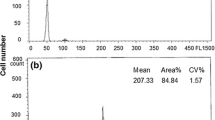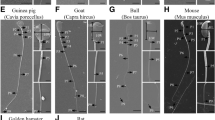Abstract
The ultrastructure of diploid and triploid tench Tinca tinca (L.) spermatozoa were examined using electron microscopy focusing on parameters that influence movement. Triploid tench were produced artificially using a cold shock. Spermatozoa of triploid males in comparison with diploids featured significantly larger head (P < 0.01), higher amount of mitochondria (P < 0.05), and, surprisingly larger widths of the peripheral doublets and central pair of microtubules and the single microtubule (P < 0.01). However, the diameters of the flagellum were without significant differences as well as the length of the flagellum and length and width of the midpiece. Also motility parameters of spermatozoa did not significantly differ between diploid and triploid males, but the total velocity (summary of spermatozoa velocity and duration of movement) positively correlated with the flagellum length and negatively with the head diameter of tench spermatozoa with a high significant influence (P < 0.01).




Similar content being viewed by others
References
Alavi SMH, Psenicka M, Rodina M, Policar T, Linhart O (2008a) Changes of sperm morphology, volume, density and motility and seminal plasma composition in Barbus barbus (Teleostei: Cyprinidae) during the reproductive season. Aquat Living Resour 21:75–80
Alavi SMH, Psenicka M, Policar T (2008b) Sperm characteristic in Barbus barbus as a function of nutrition throughout the reproductive season. Cybium 32:200–201
Baccetti B, Burrini AG, Callaini G, Gibertini G, Mazzini M, Zerunian S (1984) Fish germinal cell. I. Comparative spermatology of seven cyprinid species. Gamete Res 10:373–396
Benfey T, Solar I, de Jong G, Donaldson E (1986) Flow-cytometric confirmation of aneuploid in sperm from triploid rainbow trout. Trans Am Fish Soc 115:838–840
Buchtova H, Svobodova Z, Flajshans M, Vorlová L (2003) Analysis of growth, weight and relevant indices of diploid and triploid population of tench Tinca tinca (Linnaeus 1758). Aquacult Res 34:719–726
Chourrout D, Chevassus B, Krieg F, Happe A, Burger G, Renard P (1986) Production of second generation triploid and tetraploid rainbow trout by mating tetraploid males and diploid females-potential of tetraploid fish. Theor Appl Genet 72:193–206
Christen R, Gatti JL, Billard R (1987) Trout sperm motility. Eur J Biochem 166:667–671
Cosson J, Billard R, Cibert C, Dréanno C, Suquet M (1999) Ionic factors regulating the motility of fish sperm. In: Gagnon C (ed) From basic science the male gamete to clinical application. Cache River Press, Vienna, pp 161–186
Davis C, Gull K (1983) Protofilament number in microtubules in cells of two parasitic nematodes. J Parasitol 69:1094–1099
Devlin RH, Nagahama Y (2002) Sex determination and sex differentiation in fish: an overview of genetic, physiological, and environmental influences. Aquaculture 208:191–364
Donaldson EM, Devlin RH (1996) Uses of biotechnology to enhance production. In: Pennell W, Barton B (eds) Principles of salmonid culture. Elsevier, Amsterdam, pp 969–1020
Dong Q, Huang C, Tiersch TR (2005) Spermatozoal ultrastructure of diploid and tetraploid Pacific oyster. Aquaculture 249:487–496
Flajshans M, Linhart O, Kvasnicka P (1993a) Genetic studies of tench (Tinca tinca L.). Induced triploidy and tetraploidy and first performance data. Aquaculture 113:301–312
Flajshans M, Kvasnicka P, Rab P (1993b) Genetic studies in tench (Tinca tinca L.). A high incidence of spontaneous triploidy. Aquaculture 110:243–248
Flajshans M, Kocour M, Gela D, Piackova V (2004) The first results on relationships aminy amphimictic diploid, diploid gynogenic and triploid tench, Tinca tinca L. under communal testing. Aquacult Int 12:103–118
Humphries S, Evans JP, Simmons LW (2008) Sperm competition: linking form to function. BMC Evol Biol 8:319
Hussain MG, Panman DJ, McAndrew BJ (1996) Effects of triploidy on sexual maturation and reproduction in Nile tilapia, Oreochromis niloticus L. In: ICLARM Konference Proceedings. ICLARM, Makati City, Philippines, pp 320–325
Jamieson BGM (1991) Fish evolution and systematics: evidence from spermatozoa. Cambridge University Press, Cambridge, pp 230–295
Kohlman K, Kersten P (2006) Microsatellite loci in tench: isolation and variability in a test population. Aquacult Int 14:3–7
Lincoln RF, Scott AP (1983) Production of all-female triploid rainbow trout. Aquaculture 30:375–380
Linhart O, Billard R (1995) Biology of gamets and artificial reproduction in common tench (Tinca tinca L.). Pol Arch Hydrobiol 42:37–56
Linhart O, Rodina M, Bastl J, Cosson J (2003) Urinary bladder ionic composition of seminal fluid and urine with characterization of sperm motility in tench (Tinca tinca L.). J Appl Ichthyol 19:177–181
Linhart O, Rodina M, Flajshans M, Mavrodiev N, Nebesarova J, Gela D, Kocour M (2006) Studies on sperm of diploid and triploid tench. Tinca tinca (L.). Aquacult Int 14:9–25
Linhart O, Alavi SMH, Rodina M, Gela D, Cosson J (2008) Comparison of sperm velocity, motility and fertilizing ability between firstly and secondly activated spermatozoa of common carp (Cyprinus carpio). J Appl Ichthyol 24:386–396
Psenicka M, Rodina M, Nebesarova J, Linhart O (2006) Ultrastructure of spermatozoa of tench Tinca tinca observed by means of scanning and transmission electron microscopy. Theriogenology 66:1355–1363
Psenicka M, Alavi SMH, Rodina M, Gela D, Nebesarova J, Linhart O (2007) Morphology and ultrastructure of Siberian sturgeon, Acipenser baerii, spermatozoa using scanning and transmission electron microscopy. Biol Cell 99:103–115
Psenicka M, Alavi SMH, Vancova M, Koubek P, Tesitel J, Linhart O (2008a) Fine structure and morphology of sterlet (Acipenser ruthenus L. 1758) spermatozoa and acrosin localization. Anim Reprod Sci, in press
Psenicka M, Alavi SMH, Rodina M, Cicova Z, Gela D, Cosson J, Nebesarova J, Linhart O (2008b) Morphology, chemical contents and physiology of chondrostean fish sperm: A comparative study between Siberian sturgeon (Acipenser baerii) and sterlet (Acipenser ruthenus). J Appl Ichthyol 24:371–377
Purdom CE (1983) Genetic engineering by the manipulation of chromosomes. Aquaculture 33:287–300
Rodina M, Cosson J, Gela D, Linhart O (2004) Kurokura solution as immobilizing medium for spermatozoa of tench (Tinca tinca L.). Aquacult Int 12:119–131
Stoltz JA, Neff BD (2006) Sperm competition in a fish with external fertilization: the contribution of sperm number, speed and length. J Evolution Biol 19:1873–1881
Svobodova Z, Kolarova J, Flajshans M (1998) The first finding of the differences in complete blood count between diploid and triploid tench, Tinca tinca L. Acta Vet Brno 67:243–248
Thorgaard GH (1983) Chromosome set manipulation and sex control in fish. Academic Press, New York, pp 405–434
Ueda T, Sawada M, Kobayashi J (1987) Cytogenetical characteristics of embryos between diploid female and triploid male in rainbow trout. Japan J Genet 62:461–465
Vindelov LL, Christensen IJ (1990) Review of techniques and results obtained in one laboratory by an integrated system of methods designed for routine clinical flowcytometric DNA analysis. Cytometry 11:753–770
Zuromska H, Markowska J (1984) The effect of sexual products quality on offspring survival and quality in tench (Tinca tinca L.). Pol Arch Hydrobiol 31:287–313
Acknowledgments
The study was financially supported by project of USB RIFCH no. MSM6007665809, GACR no. 523/08/0824.
Author information
Authors and Affiliations
Corresponding author
Rights and permissions
About this article
Cite this article
Pšenička, M., Flajšhans, M., Hulák, M. et al. The influence of ploidy level on ultrastructure and motility of tench Tinca tinca (L.) spermatozoa. Rev Fish Biol Fisheries 20, 331–338 (2010). https://doi.org/10.1007/s11160-009-9135-0
Received:
Accepted:
Published:
Issue Date:
DOI: https://doi.org/10.1007/s11160-009-9135-0




